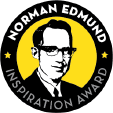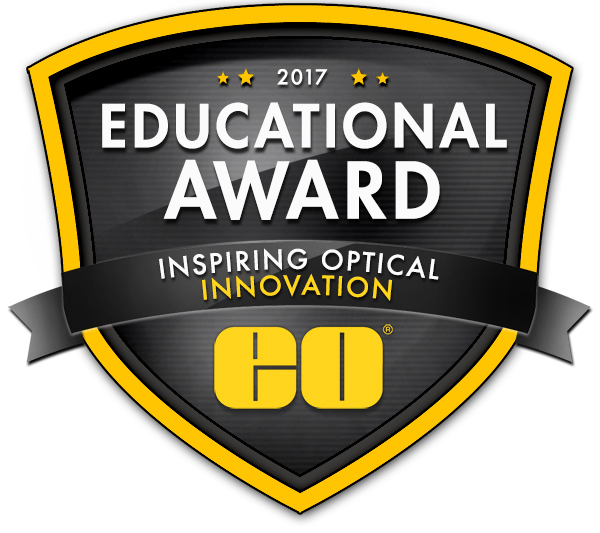

Norman Edmund Inspiration Award — $5,000 in Products
Colorado State University , United States — Submitted by Justin Sambur
Mr. Sambur’s proposed project uses light sheet microscopy to directly visualize solar energy conversion processes along the length of a single nanowire. The long-term goal of this project is to inform materials scientists on how to synthesize the optimal electrode architecture for solar energy conversion applications. To inspire the next generation of scientists to engage in optics and nanoscience, Sambur and his team have developed a LEGO microscope that uses a smart phone camera to image single fluorescent nanoparticles. “Seeing is believing,” said Sambur. “However, it is impossible for K-12 and most undergraduate science students to see nanoscale materials because they lack sophisticated imaging capabilities.” The students learn first-hand the challenges associated with “seeing” single nanoparticles using visible light. His team developed step-by-step instructions that shows students how to determine the smart phone camera pixel size using a conventional metric ruler. Most importantly, the activity exposes young students to optical concepts and gives them hands-on experience using optical components, ultimately providing them with the rewarding experience of building a fully-functional optical microscope for nanoparticle imaging.

 Americas — $10,000 in Products
Americas — $10,000 in Products
Institut National de la Recherche Scientifique, Canada – submitted by Jinyang Liang
For the development of compressed ultrafast microscopy (CUMic) to image neuronal activities in real time. Optical neuroimaging is a potent emerging approach to mapping neural activities. It has inherent advantages in non-invasiveness, large recording parallelism, multiple-parameter sensing, and high spatiotemporal resolution and scalability. The success of optical neuroimaging has two essential constituents: indicators of neural activities and optical imaging instruments. Despite recent advances in fast-response, high-sensitivity voltage and calcium indicators, progress in optical instrumentation has not kept pace. Limitations in imaging speed, light throughput, pixel counts, scalability, sensitivity, and/or imaging depth in existing imagers have severely hampered the scope and measurement accuracy of neural activities under interrogation. The development of this novel instrumentation intends to bridge the gap between the Biomedical, Physics, and and Engineering fields by utilizing ultra-fast and photo-acoustic imaging.

 Europe — €7,000 in Products
Europe — €7,000 in Products
Universität Innsbruck, Austria – submitted by Thorsten Schwerte
For the disruption of host targeting in blood feeding flight insects by dynamic light pattern projection in dark and light rooms. In this project the hypotheses that flight insects, including blood seeking ones, which rely on optical feedback from their environment can be “flight-controlled” by projected landmarks using dynamic light patterns is being examined. Only a few recent studies support the hypothesis that vision control is important for the navigation of blood seeking insects to the host. The mosquito’s perception of different wavelengths enables them to see IR light (860 nm). Being invisible to humans, IR light does not interfere with the human vision system. As blood-seeking flight insects are one of the most dangerous animals on earth, a low-cost optical system for active, non-poisonous protection of humans from mosquito bites would have a high impact on third world development. In addition, the outcome of this project provides a deeper understanding of the strategies of flight navigation in insects.

 Americas — $7,500 in Products
Americas — $7,500 in Products
Universidad Nacional de Quilmes, Argentina – submitted by Fernando Alvira
For the implementation of an interferometric spectrometer for Raman Spectroscopy as a tool to diagnose Alzheimer‘s Disease. In the next 50 years, Alzheimer‘s Disease will affect 100 million people globally. Current methods and techniques pose limiations for a reliable laboratory method to diagnose the early detection of Alzheimer‘s Disease in an individual. However, Raman Spectroscopy has shown tremendous potential to detect the disease in early stages of development, due to this non-invasive and non-destructive method. The main drawback of this approach is the cost involved. To address this issue, the team will develop an inexpensive detector for Raman spectroscopy with an excitation in Ultra-Violet region. The spectral information obtained from samples of the brain of animals with Alzheimer‘s Disease will be analyzed by a statistical algorithm employed to extract information from Raman spectra. The main advantage of this technique is the equipment will be the cheapest than any commercial Raman instrument known to date.

 Europe — €5,000 in Products
Europe — €5,000 in Products
Delft University of Technology, The Netherlands – submitted by Hai Gong
For the development of a smart optical malaria diagnostic instrument, deployable to low-resource settings. This instrument will operate with minimal human intervention: malaria parasites in human blood samples will be detected with highly sensitive and specific optics without deploying conventional staining methods. Since this conventional method is laborious and its accuracy depends on the expertise of the microscopist, a low-cost and label free diagnostic method is to be developed. The goal of this project is to achieve fast diagnoses without laborious sample preparation by combining the following imaging modalities: digital holography (providing phase information on deformation of the red blood cells), polarization sensitive imaging (for the detection of malaria pigments in blood sample), hyperspectral imaging and surface plasmon resonance microscopy. As a result, a multi-modal system, which provides reliable and accurate measurements for malaria diagnoses will be implemented. In addition, a smart algorithm for the recognition and counting of the parasites in the measured data will be incorporated into the device.

 Americas — $5,000 in Products
Americas — $5,000 in Products
Boston University, United States – submitted by Daniel Leman
For the design of a lightweight, 3D-printed, wireless-capable microscope for single photon fluorescence imaging in awake, behaving animals. This system utilizes blue light, focused through a drum lens, to excite a green fluorophore. Light is collimated through a GRIN lens, and emitted light travels through an achromat doublet to the sensor. With a 3D printed design, these microscopes can quickly adapt and redesign a variety of single-fluorescence applications. The current design serves users imaging green fluorophores, namely GFP/GCaMP, via small (700 micron) fields of view. However, there is interest in developing a wide field imaging version of these “miniscopes” to image larger neural structures, like olfactory bulb. The ultimate goal of this project is the development of a lower-cost, open source option compared to what is commercially available. With the adaptability of this design, users can easily implement microscopes and change them to fit their specific optical needs and purposes.

 Europe — €3,000 in Products
Europe — €3,000 in Products
Justus-Liebig-Universität Gießen, Germany – submitted by Florian Bayer
For the development of a 4-fold DLP projection system with filtered high power LEDs to investigate previously inaccessible, fundamental mechanisms of signal processing of the human retina. For this purpose, a scientific device has to comply with two requirements: independent control of the stimulation of all photoreceptors (L-, M-, S-cones, and rods) and a spatial and temporal resolution appropriate for vision science. Previous devices failed to meet both requirements at the same time, which limited the progress in this research area for many years. With this developed projection system, light can be shed on the properties of different signal pathways in the retina as well as on their interactions. This provides a unique possibility to investigate how the first stage of visual processing works, how it shapes visual perception, and how it is altered in certain retinal diseases. One goal of this work is to conduct and to publish psychophysical studies on retinal processing and its consequences for perception. The benefit is to provide missing fundamental parts to the puzzle of how visual information is processed in the retina. In addition, the goal to examine patients with retinal diseases with respect to changes in retinal processing provides a better understanding of the causes and consequences of those diseases. The third goal is to identify medical applications in eye health care and to re-design and commercialize it accordingly. The benefit is to provide a new sophisticated method for diagnosing retinal diseases and evaluating the effects of medical treatments.

or view regional numbers
QUOTE TOOL
enter stock numbers to begin
Copyright 2023, Edmund Optics Inc., 14F., No.83, Sec. 4, Wenxin Road, Beitun District , Taichung City 406, Taiwan (R.O.C.)
California Consumer Privacy Act (CCPA): Do Not Sell My Information